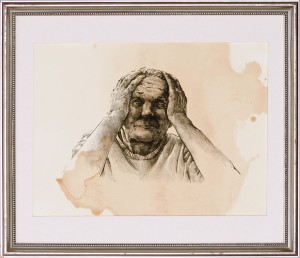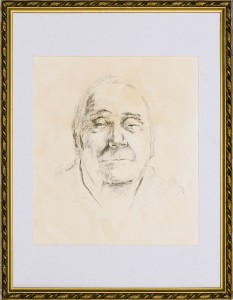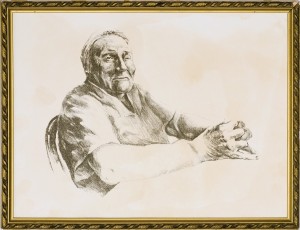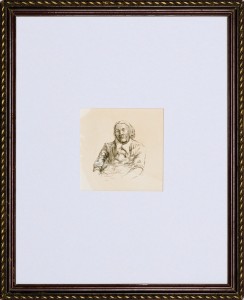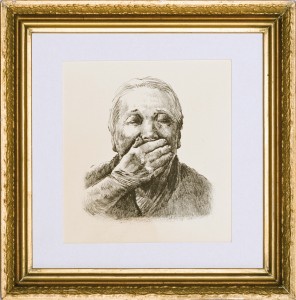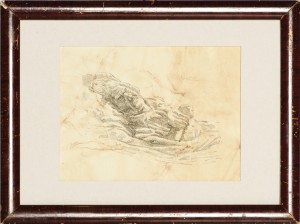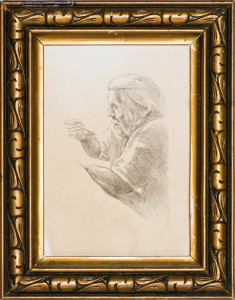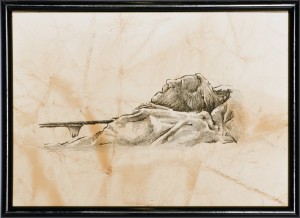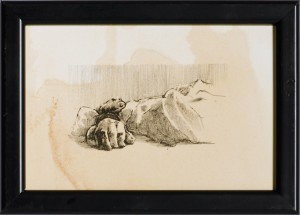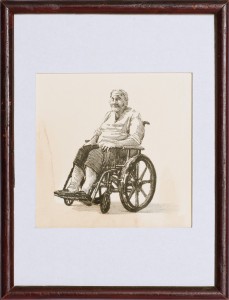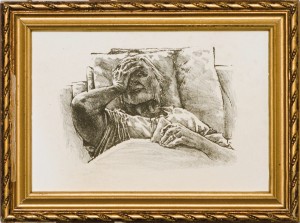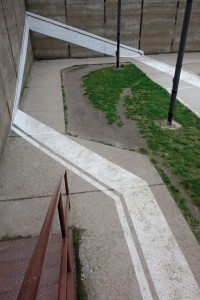White Spots
White Spots is a project dedicated to my late grandmother Halina, who for many years suffered from Altzheimer disease. The first part is a series of lithographic portraits of Halina, based on few photos and my own memory, aimed at recreating her appearance and the way she moved. The second part is a multimedia piece – I decided to recreate the world of my grandmother, enter her mind, create a virtual space based on the room where she spent most of her life. Inability to leave the room reflects imprisonment of a sick person within her own mind.
∞
Mural completed at the exercise yard of the Detention Centre in Warsaw-Białołęka presents the Mӧbius strip, regarded a symbol of infinity, continuous duration, constant returns to the starting point. Months and years lived by prisoners and persons at liberty are significantly different from each other in subjective perception of passing days. One of the prisoners serving years-long time agreed to tell me about his experiences and mechanisms of return to prison.
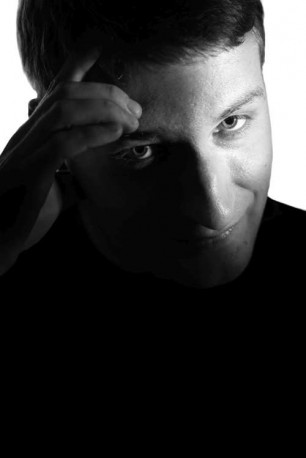
That is tabula rasa? According to one concept – it is a white card, the state of purity and innocence, or if you prefer, ignorance, as according to the theory – we are born unrecorded, equipped with cognitive tools that are used to tame, encode and decode the reality. Everything we experience in the process called life is a record. So theoretically, over time we become more pronounced, more eloquent, or – to put it differently – more dirty. Or maybe, changing the perspective – only in the beginning we are just not smeared, not corrupted? We never enter the same water, because both the water flows rapidly, and we ourselves undergo constant changes. Everything we experience gives form to our souls, but we also continually leave traces and change the surrounding reality. But what can be done when the process is disrupted, reversed? And the lack of precision of the language that starts to fail in describing our world is caused by a disease, medically described as depletion of ability to compensate functions of damaged neurons?
The project White Spots refers to an illness of the soul and body, when the process of learning the world becomes reversed. The phenomenon occurring then takes the form of a retracted wheel of time, which indeed turns, but the person experiencing the disease slowly loses landmarks, and everything that used to be subjected to natural conjunction, loses its meaning.
The reality tamed over years, despite the will, desire, attempts made to stop it, becomes alien, and the baggage of collected experiences becomes a kind of holey bag, that slowly and inevitably sheds fragments of memories and everything constituting our uniqueness and individuality.
The disease makes the world an impossible riddle, scattering like puzzle pieces the sick person is no longer able to put together. Items detach from their meanings and our card gets cleared.
Adam Walas’s project White Spots is about the tabula rasa and the disease that makes a man reduced to unimportant here and now, stuck in homogeneous time-space continuum, with no point of reference. Time and again we fall into a trap in a white room, because everything loses its gravity; portrait on the wall, clock, calendar become fractions of reality that refer to the void.
The man dies with no knowledge in the mind, detached from the past, devoid of emotions, feelings; leaves without a word.
Supervisor
Professor Błażej Ostoja Lniski
Text
Magdalena Boffito, MFA
∞
Detention Centre in Warsaw-Białołęka. Exercise yard. Space so large that you could fit a volleyball court. Closed with concrete walls on each side. From the top covered with a thick mesh. Fine white lines and planes stretch on the concrete. When we follow them, they will form a version of the Mӧbius strip – a symbol of infinity.
It is Adam Walas’s degree piece. A challenge and meditation on time and space, a category present in prison in a special way. When time and space are oppressive. The Mӧbius strip drawn in the space of the yard reorganises and changes it. It can also change the time spent in prison. It appeals much more to the recipient’s response than to actions and intention of the artist.
Murals, like it or not, go beyond privacy, and Adam has often involved in social issues. Bringing the idea of mural to such a simple and ascetic form is a challenge. Implementation of this project proved to be another challenge. Collaboration on implementation with an inmate – just another one.
However, when we watch the film record of a conversation with him, it seems that taking such challenges makes sense and brings response, which cannot always be expected in such a risky situation.
Dr. hab. Grażka Lange
B. 1985; studies at the Faculty of Graphic Arts of the Academy of Fine Arts in Warsaw (2009–2014). Fields of artistic activity: printmaking, mural, painting, multimedia. Solo exhibitions: What Will You Do?, Turbo Gallery, Warsaw, 2011; Ludzina, Przy Automacie Gallery, Cardinal Stefan Wyszyński University, Warsaw, 2012; Ludzina vol. 2, OSiR Club, Warsaw, 2012. First prize in 1944 Graffiti competition, 2009; award in the Illustration Startup competition, 2011; First Prize of the Year 2013 in the Warsaw Graphics contest.
505 070 649
adam.walas@gmail.com
